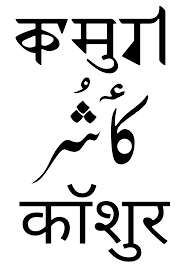Language/Kashmiri/Grammar/Adjectives
Hi Kashmiri learners! 😊
In this lesson, we will be diving into the interesting world of adjectives in Kashmiri grammar. Adjectives are used to describe nouns and add more meaning to the sentence. In Kashmiri, adjectives come after the noun and are invariable in form.
Take some time to dive into these other pages after completing this lesson: Pronouns, How to Use "Have", Gender & Questions.
Kashmiri Adjectives[edit | edit source]
In Kashmiri, adjectives are used to describe a noun and provide more information about the noun's characteristics. They come after the noun they describe, unlike in English where they come before.
For example:
- sheniwaar snoon - beautiful snow
- vuzhaan tsamik - hot tea
In the above examples, 'snoon' and 'tsamik' are the nouns (snow and tea), and 'sheniwaar' and 'vuzhaan' are the adjectives (beautiful and hot). Notice how the adjectives come after the noun it describes.
Types of Adjectives[edit | edit source]
There are several types of adjectives in Kashmiri, including:
- Quality Adjectives
- Quantity Adjectives
- Possessive Adjectives
- Demonstrative Adjectives
Each of these types of adjectives have their own unique functions in the sentence. Let's explore each type in more detail.
Quality Adjectives[edit | edit source]
Quality adjectives describe the quality or characteristic of a noun. Here are some examples:
| Kashmiri | Pronunciation | English |
|---|---|---|
| metchith | met-chith | sweet |
| vawran | va-ran | blue |
| shaandar | shaan-dar | marvelous |
In the following dialogue, the quality adjective 'metchith' (sweet) is used to describe the noun 'haak' (vegetable).
- Person 1: yi haak hund metchith yi? (Is this vegetable sweet?)
- Person 2: chai, yi meetchith (Yes, it is sweet.)
Quantity Adjectives[edit | edit source]
Quantity adjectives are used to indicate the amount or quantity of a noun. Here are some examples:
| Kashmiri | Pronunciation | English |
|---|---|---|
| tyeth | tyeth | some |
| zyaada | zya-da | more |
| gatchh | ga-chh | enough |
In the following dialogue, the quantity adjective 'tyeth' (some) is used to describe the quantity of the noun 'hakk' (vegetable).
- Person 1: kaasa haak shyaarev chaain? (How many vegetables do you want?)
- Person 2: yi baechhiv baendlis tyeth hakk chu (I want to buy some vegetables including okra).
Possessive Adjectives[edit | edit source]
Possessive adjectives are used to indicate possession or ownership of a noun. Here are some examples:
| Kashmiri | Pronunciation | English |
|---|---|---|
| hund | hund | my |
| tsay | tsay | your |
| aas | aa-s | his/her |
In the following dialogue, the possessive adjective 'hund' (my) is used to indicate ownership of the noun 'trand' (book).
- Person 1: yi trand kya tschu? (Is this your book?)
- Person 2: chai tsay trand kyah chu, lakin yi hund trand kyah chu (Yes, this is your book but this is my book)
Demonstrative Adjectives[edit | edit source]
Demonstrative adjectives are used to point out a particular noun or to indicate proximity. Here are some examples:
| Kashmiri | Pronunciation | English |
|---|---|---|
| yyih | y-yih | this |
| tuh | tuh | that |
| asaan | aa-saan | those |
In the following dialogue, the demonstrative adjective 'tuuh' (that) is used to indicate distance from the speaker.
- Person 1: kaaemut tcheh dzan chum? (What can I do for you?)
- Person 2: tuuh kovaen karaem chaan, yi tcheh chus yodnas dyutaav zaeth. (Do that work, I am planning to buy this sweater.)
Adjective Agreement[edit | edit source]
In Kashmiri, adjectives are invariable in form and do not agree in gender or number with the noun they describe.
For example:
| Kashmiri | Pronunciation | English |
|---|---|---|
| suji kand | su-ji kan-d | good apple (masculine) |
| suji chuhur | su-ji chu-hur | good fruit (feminine) |
In the above examples, 'suji' (good) remains the same whether the noun is masculine (kand) or feminine (chuhur).
Conclusion[edit | edit source]
Adjectives play an important role in adding more meaning to a sentence and providing more details about a noun in Kashmiri grammar. Possessive, demonstrative, quality and quantity adjectives all have unique functions in a sentence. Always remember, practice makes perfect! To improve your Kashmiri find native speakers and ask them any questions. Also, check out our grammar section for more interesting lessons in Kashmiri.
➡ If you have any questions, please ask them in the comments section below.
➡ Feel free to edit this wiki page if you think it can be improved. 😎
Congratulations on finishing this lesson! Explore these related pages to keep learning: Alphabet and Pronunciation, Say Hello and Greetings in Kashmiri, How to Use Be & Plurals.
Videos[edit | edit source]
Kashmiri Grammar ADJECTIVE AND TYPES(باوُت)(صفت)FOR ALL ...[edit | edit source]
kashmiri Grammer: adjectives and its kinds (bawut complete ...[edit | edit source]
Bawut (باؤت) (Adjective) Grammar, Subject Kashmiri - YouTube[edit | edit source]
Other Lessons[edit | edit source]
Sources[edit | edit source]
- Kashmiri Grammar ADJECTIVE AND TYPES(باوُت)(صفت)FOR ALL ...
- Kashmiri language - Wikipedia
- kashmiri Grammer: adjectives and its kinds (bawut complete ...

